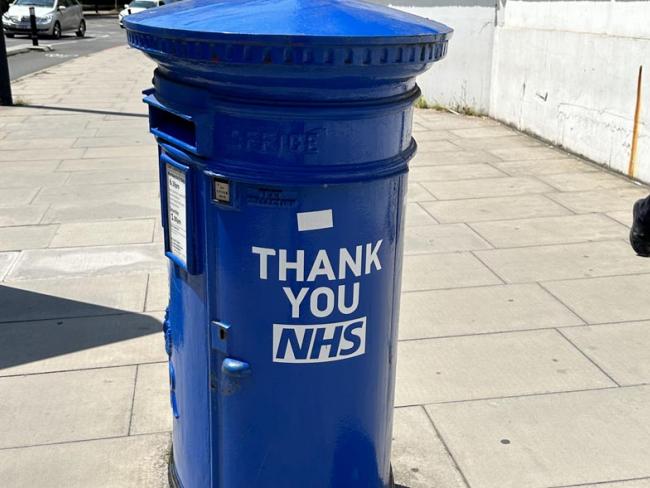
Postbox outside St Thomas’s Hospital, London. Photo Workers.
Launched in 1948, the NHS wasn’t given to us by benign politicians. It was won by workers fighting over centuries for a health service for all. …
In the wake of the industrial revolution, Britain was transformed from an agrarian, rural nation into an industrial, urban one. Within a short timeframe, people congregated in towns and cities, with an explosion of disease, industrial injuries, and destitution. Poor water supply, drainage and refuse disposal were major contributory causes of cholera outbreaks. Life was grim.
An early success in the battle for quality and affordable healthcare was the foundation of The Keelmen’s Hospital of Newcastle in 1701. The men’s work was arduous, loading coal from the banks of the shallow rivers Tyne and Wear on to keel boats then unloading them on to ships further out to sea.
Keelmen were rarely able to continue with the work beyond age 40. Families could be devastated, emotionally and financially, by injury or illness. But they were organised. They had to be. After many pay and conditions disputes with the employers, they began a campaign in 1698 for a hospital for their families, funded by each keelman paying a penny a tide. The Newcastle Corporation provided a site for the hospital, and it was completed in 1701.
Initially the employers insisted that they should manage the hospital fund – claiming that it was important that the money wasn’t siphoned into strike pay! That didn’t stop the keelmen and their families. They fought to wrest control of the management of the hospital from their employers – and they succeeded. The hospital continued until the demise of the job of keelman in the late 1800s.
A more recent example, still in existence in 1948, was the Tredegar Workmen’s Medical Aid and Sick Relief Fund first launched by miners and other organised workers through their unions in 1890. Workers paid a regular subscription for medical care for them and their families.
Like the keelmen of the previous century, they campaigned for a hospital. And when that was built in 1904, they didn’t sit back. Instead, they fought to ensure they had control of the hospital and fund management.
By the 1930s the scheme was providing almost all Tredegar’s people with healthcare.
The National Insurance Act of 1911 introduced a compulsory system of contributory health insurance for a major section of the manual workforce. Over 11 million workers were covered at the outset, rising to 20 million (43 per cent of the population) by 1938.
In addition to a weekly receipt of sickness benefit, members and their families were eligible for “adequate” medical attendance and treatment, without further payment, from their chosen “panel” doctor. By 1938, 90 per cent of all active general practitioners were involved in the scheme. Hospital treatment was excluded, except for tuberculosis.
Varying standards
The standard of “adequate” medical treatment varied. A GP, writing of his experiences before the second world war, recalled the waiting room with rows of seats for about 60 patients who sat facing a high bench. Behind stood three doctors and, behind them, the dispenser. The doctor called the next patient to come forward. Having listened to the complaint, he turned to the dispenser to order the appropriate remedy. There was rarely any attempt at examination.
Voluntary hospitals, aimed at the “sick poor”, provided the bulk of emergency care and relied largely on charity. They were staffed by physicians and surgeons who donated their time and expertise while making a living from their private practice.
Municipal hospitals, a vestige of the old workhouse hospitals (created under the Poor Laws of the Tudor times onwards), were run by local authorities.
But by the 1930s hospitals across the country were facing financial crisis and growing waiting lists.
‘Reorganisations, mismanagement and underfunding have always been part of the NHS…’
The wartime period led to the creation of the Emergency Hospital Service to care for the wounded, when the government was forced to recognise that the existing services could not cope with war casualties. This new service created about 65,000 extra hospital beds; surgical and other hospital facilities were upgraded,and specialised treatment centres were developed.
By 1941, the Ministry of Health was developing a post-war health policy with the aim that services would be available to the entire population. A year later the Beveridge Report recommended that the government create “comprehensive health and rehabilitation services”.
Given the strong public support for the Report, it was eventually supported across the House of Commons.
In 1944 the government endorsed a White Paper which set out the guidelines for the NHS. This was to be funded from general taxation not national insurance. Everyone was entitled to treatment, provided free at the point of delivery.
But great as that achievement was, the NHS has never been a fully comprehensive and preventative health system. It acts as a safety net that cannot compensate for bad diet, ignorance, or poor housing.
Reorganisations, mismanagement, and underfunding have been part of NHS history since it was founded – the past ten years have not been exceptional. Prescription charges, introduced by one Conservative government and abolished in 1965 by another, were re-introduced by a Labour government in 1968. And for many a visit to the dentist has become a luxury they cannot afford.
We can learn from our forefathers – the keelmen of Newcastle and the working people of Tredegar – who recognised the need to demand a quality, comprehensive healthcare system and also the need to maintain control of that system.
